By Kyle Orton (@KyleWOrton) on August 31, 2016
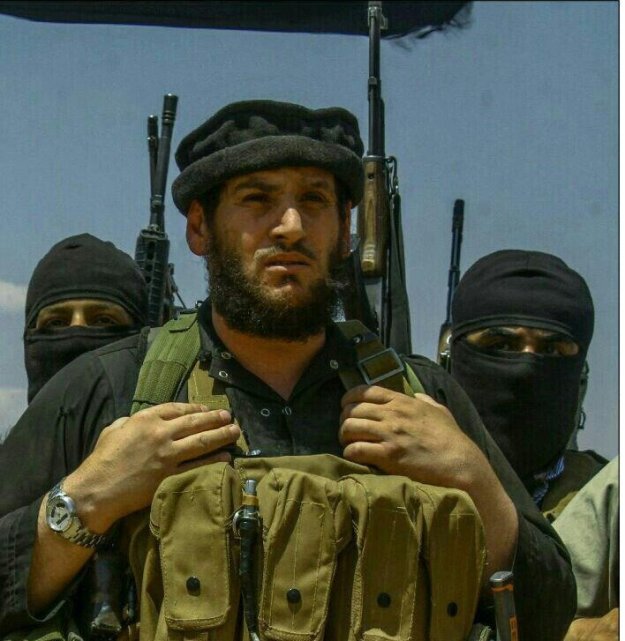
Taha Falaha (Abu Muhammad al-Adnani) in al-Naba
The Islamic State confirmed yesterday, via their “news” agency Amaq, that Taha Subhi Falaha had been killed in Aleppo. Falaha had gained global notoriety under his kunya, Abu Muhammad al-Adnani, after his September 2014 speech calling on Muslims in the West to “kill any disbeliever” in range, and to at least “spit in his face” if one was unable to find a knife or a car or a rock to do murder with.
Falaha was often referred to as the spokesman of IS, and so he was—the voice of the organization since 2011. He was also from the first generation of the organization, recruited before the invasion of Iraq, one of the few within the organization of that stature. But, as I explained recently in a paper for the Henry Jackson Society that compiled what is known of IS’s leadership, Falaha was much more than a figurehead.
Falaha was the governor of IS-held areas in Syria and the man who oversaw the external terrorist attacks. By now he was the caliph’s effective deputy. Heretofore, IS’s impressive bureaucracy has managed to replace individuals with minimal perturbation. IS will experience few perturbations quite like this.
In the Beginning
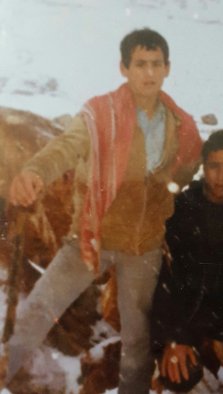
Taha Falaha at 16 (1993)
Born in 1977 in Binnish in the Idlibi countryside, Falaha had been a part of a Jihadi-Salafist group since 2000, working against the Bashar al-Assad regime, according to a biography of Falaha released by IS’s now-chief religious official, Turki al-Binali.
In April 2002, IS’s founder, Ahmad al-Khalayleh (Abu Musab al-Zarqawi), had moved his organization into Saddam Hussein’s Iraq, and al-Khalayleh had moved to Baghdad in May with a dozen senior Qaedaists. Over the summer of 2002, al-Khalayleh toured Lebanon and Syria recruiting, and organizing—with the help of Assad’s intelligence services—the assassination of an American diplomat in Jordan and the “ratlines” that brought the foreign jihadis to IS’s predecessor. Falaha was among a group of thirty-five in Aleppo who pledged allegiance to al-Khalayleh and departed for Iraq to wait for the Americans, al-Binali says.
Al-Khalayleh moved back to Baghdad and then to territory held by Ansar al-Islam in northern Iraq in November 2002 after a second request was made through Amman for Saddam to arrest al-Khalayleh. Al-Khalayleh, his men, and the Ansar jihadists fled to Iran during the invasion, likely with Falaha among them.
Al-Khalayleh and Ansar returned to Iraq in the early summer of 2003, assisted by both the fallen Saddam regime and Iran, and largely went their own way until a merger in 2014. With a series of “spectacular” terrorist attacks in Baghdad against international targets and against a Shi’a shrine in Najaf in August 2003, the insurgency had begun and al-Khalayleh’s men had arrived.
The Americans would insist all was well, but those on the ground sensed the growing disorder and the strength of al-Khalayleh’s wing of the insurgency as against the Ba’athi-Salafists and the tribesmen. Falaha was associated with the early ideological leadership of the IS movement, al-Binali says, men like Mustafa Darwish (Abu Muhammad al-Lubnani) and Umar al-Juma (Abu Anas al-Shami), and devised the jihadists’ training programs.
Falaha was free when al-Khalayleh’s organization swore allegiance to al-Qaeda and became al-Qaeda in Iraq (AQI). But he was arrested on 31 May 2005, and held until 2010, so missed out on the complicated and contested process by which AQI, after al-Khalayleh was killed, became the Islamic State of Iraq (ISI) in November 2006, and the strategic defeat of the organization in 2008.
Creating the Caliphate
Falaha was shielded by his imprisonment during the relentless grinding down of ISI’s leadership in 2008 and 2009, and it is unclear whether he was still behind-the-wire during the near-decapitation of the organization between April and June 2010, which killed off the emir, Hamid al-Zawi (Abu Umar al-Baghdadi) and his deputy, Abd al-Munim al-Badawi (Abu Hamza al-Muhajir), leading to their replacement by Ibrahim al-Badri (Abu Bakr al-Baghdadi).
IS had—largely unnoticed—reacted to the surge-and-sahwa, however, so that by mid-2011 it was on the “upswing” and able to dispatch seven senior leaders (p. 9) to Syria as an advanced party to set up an ISI wing there. Falaha, though a Syrian, was not sent on this mission. Ahmad al-Shara (Abu Muhammad al-Jolani) would lead Jabhat al-Nusra, now rebranded Jabhat Fatah al-Sham (JFS) and ostensibly “split” from al-Qaeda. Instead, Falaha became ISI’s spokesman in August 2011.
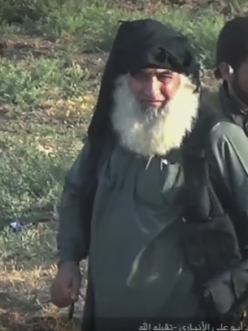
Abd al-Rahman al-Qaduli (Abu Ali al-Anbari)
Throughout 2012, al-Nusra was becoming increasingly independent. In December 2012, al-Badri’s deputy, Samir al-Khlifawi (Haji Bakr, Abu Bakr al-Iraqi) transferred to Syria to try to bring al-Shara to heel. Al-Khlifawi seems to have been accompanied by Falaha, who tried to orchestrate an attack against ETILAF, the political wing of the Syrian opposition, in Turkey. Al-Shara stopped him, and this is the moment ISI knew it had lost control of al-Nusra. Another man who moved into Syria either with al-Khlifawi or soon after is Abd al-Rahman al-Qaduli (Abu Ali al-Anbari), ISI’s highest religious authority, who would have succeeded al-Khalayleh had he not been in prison.
Al-Khlifawi, a former intelligence officer in an elite unit of the Saddam regime, trained in conspiracy and paranoid organizations with multiple, competing lines of authority, cultivated a cadre of loyalists among al-Nusra’s membership, notably Amr al-Absi (Abu al-Atheer) and Tarkhan Batirashvili (Abu Umar al-Shishani). Al-Qaduli, with his religious prestige, was the main outreach point for this.
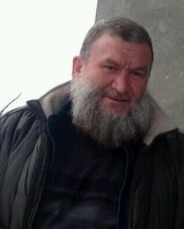
Muhammad al-Bahaya (Abu Khalid al-Suri)
So when al-Badri publicly announced the formal subordination of al-Nusra in April 2013—and it was inevitably rejected by al-Nusra—there were already large sections of al-Nusra that belonged to him. Al-Absi particularly was able to bring with him most of al-Nusra’s infrastructure in Aleppo and a majority of the foreign fighters. In tandem with the withdrawal of ISI’s subsidies, it crippled al-Nusra, and without Ahrar al-Sham, specifically under the instructions of Muhammad al-Bahaya (Abu Khalid al-Suri), it is anyone’s guess if al-Nusra would have survived the schism with its parent organization.
Split with Al-Qaeda
Al-Qaeda’s leader, Ayman al-Zawahiri, ruled on 24 May 2013 that ISI should return to Iraq and al-Nusra should remain in Syria as an independent branch of al-Qaeda. This was leaked to Al-Jazeera on 9 June 2013. Al-Bahaya was appointed al-Zawahiri’s representative in Syria to enforce the ruling. ISIS had accepted al-Zawahiri’s authority—until he ruled against them. On 14 June, al-Badri released an audio statement that firmly but respectful rejected al-Zawahiri’s command. Facing a choice between God’s command and the command in al-Zawahiri’s letter, “I chose to abide by the command of God,” al-Badri said.
Days after al-Badri rejected al-Zawahiri’s order, it was left to Falaha to launch the all-out-ideological assault on al-Zawahiri, beginning the role that made him famous: IS(IS)’s “attack dog,” its most ferocious public advocate and the man who cast all other Islamist militants as deviant.
The ruling “attributed” to al-Zawahiri was ignorant of “the reality on the ground in Syria”, where its implementation “is not possible” and “can only bring evil consequences” if it was tried, Falaha said in his June 2013 speech, before charging that al-Zawahiri was ordering a sin against God, namely dividing Muslims—something that is “despised” in the Qur’an and invites “annihilation” in the then-present circumstances. It was to prevent, not to cause, division that ISIS “hastened its declaration” that al-Nusra was its creature, Falaha went on, and now al-Zawahiri was “validating the split of the disobedient renegades”. Falaha then accused al-Zawahiri of further violating Islamic law by demanding ISIS “adhere to the cursed [Sykes-Picot] borders”, which “contradicts our methodology and what believe in”. Al-Zawahiri was saying “the lions of the Islamic State should sit behind the berm [on the border] looking at the Muslims in Syria as their honour is violated and they are slaughtered”, concluded Falaha. “No! No one will stop us from aiding our people in Syria!” This was positively polite compared to what was to come.
Various efforts were made to reconcile ISIS and al-Nusra. But ISIS had other ideas. Having defied al-Qaeda’s leader publicly, ISIS now set-about laying the groundwork for an Islamic state. On one side this was done by recruiting members and even whole battalions from existing insurgent groups, with al-Qaduli continuing his role of religious persuasion and al-Absi working tirelessly as a “roving ambassador” for ISIS in northern Syria. On the other, al-Khlifawi penetrated communities, co-opted—by inducement, blackmail, or threat—those elements of the social elite he could and systematically eliminated those who stood in ISIS’s way.
As IS(IS) built the rudiments of a state in the second half of 2013 it came into repeated conflict with the Syrian rebels—and almost none with the Assad regime. Believing itself to be a state, then-ISIS would not submit to independent courts. Resistance continued to build until a second, massive revolt erupted in January 2014—this time against ISIS. The rebellion drove ISIS entirely from Idlib and Latakia, and expelled ISIS from most of Aleppo. Al-Khlifawi had been cut down in the early hours of this new uprising; on 23 February ISIS killed al-Bahaya.
On 3 February, al-Qaeda disowned ISIS. There are still competing narratives about what this event meant—centred on what status ISIS had had in relation to al-Qaeda. But suffice it to say this was the end of those relations.
ISIS continued its state-building now within more defensible parameters. Raqqa had come under exclusive ISIS control in the fall of 2013 and with this as their capital ISIS built up to the public takeover of Mosul and its sweep across central Iraq in June 2014. A month later, the weapons captured in Iraq would be used to secure Deir Ezzor. When ISIS announced the caliphate on 29 June 2014—becoming IS—it was Falaha who gave the speech. [Update: In the propaganda video released the same day of IS physically demolishing the Iraq-Syria border, Falaha was present with Batirashvili and the Chilean-Norwegian Bastián Vásquez (Abu Safiyyah).]
![Taha Falaha (Abu Muhammad al-Adnani) 5b [Demolishing border, square borders]](https://kyleorton1991.files.wordpress.com/2016/08/taha-falaha-abu-muhammad-al-adnani-5b-demolishing-border-square-borders.jpg?w=625)
Taha Falaha (Abu Muhammad al-Adnani) demolishing the berms on the Iraq-Syria border. [29 JUN 2014]
Rising Through the Ranks
Falaha is a long-time member of the Shura Council, which technically has the ability to remove the caliph. Falaha was also connected to the Media Council as the “main conduit for the dissemination of official [IS] messages,” as the designation put it. Falaha also likely had some oversight capacity with the Shari’a Council, vetting its dawa output.
A senior defector from IS’s security services revealed that Falaha had been the governor of IS-held areas in Syria by the time of his death.

Fadel al-Hiyali (Abu Muslim al-Turkmani, Haji Mutazz)
In August 2015, the head of IS’s Military Council, its Iraqi governor, and the caliph’s deputy, Fadel al-Hiyali (Haji Mutazz, Abu Muslim al-Turkmani), a former member of Saddam’s Special Forces, was killed. Al-Qaduli was at that point IS’s governor of Syria and the head of the Security and Intelligence Council (SIC), essentially the head of internal security (the amniyat), which roots out corruption and disloyalty among IS’s own members. The governor’s job was handed to al-Absi and Iyad al-Jumayli (Abu Yahya al-Iraqi), a former Saddam-era intelligence officer, took over the SIC. Al-Absi was killed on 3 March 2016, and was probably going to be replaced as Syrian governor by Abu Hayjaa al-Tunsi, at least around Aleppo, but Abu Hayjaa was killed on 30 March. Falaha then stepped into that role.
IS has then lost an incredible roster of military officials, including Waleed al-Alwani (Abu Ahmad al-Alwani); al-Hiyali’s replacement as Iraqi governor, Nasser al-Ubaydi (Abu Umar al-Ubaydi); Shaker al-Fahdawi (Abu Waheeb), a field commander in Anbar; and Batirashvili was, after countless false reports, finally killed on 10 July.
Still, the most significant loss prior to Falaha was al-Qaduli on 25 March, who was head of the Military Council at that time but whose primary legacy is theological.
Head of Foreign Operations
Important as Falaha undoubtedly was inside the caliphate, as governor of Syria and de facto if not de jure deputy to the caliph, he is best-known in the West for his role in heading the external operations wing of IS.
Falaha has called for “lone wolf” attacks in speeches in September 2014, June 2015, and May 2016, and every time been rewarded with an uptick in such attacks, especially in Europe. This is not a matter of chance. As IS’s statelet matured, the amniyat evolved into four branches, and one of them became a foreign intelligence service, Amn al-Kharji, which Falaha oversaw. Falaha functioned as the intermediary between foreign operatives and the caliph, signing-off on planned operations.
Falaha’s role in the external attacks was brought to light when a French citizen, Faiz Bouchrane, was arrested in Lebanon in June 2014 as he tried to bomb a Shi’a target. Bouchrane revealed to his interrogators that he had been sent by Falaha. IS has also referenced Falaha’s role in its foreign attacks in its own propaganda, albeit in a mystical form.
Falaha was the one who personally accepted pledges of allegiance from foreigners, according to Harry Sarfo, a German defector from IS. Recruits were kept blindfolded so that nobody knew what Falaha looked like. Falaha’s role intertwined the foreign attacks and propaganda: he is said to have chaired monthly meetings where he decided which of IS’s barbaric videos to disseminate as part of IS’s efforts to bring in more jihadists.
Preparing for the Caliphate’s Demise
IS has lost about half of its territory in Iraq and about a fifth in Syria. As the statelet has come under pressure, IS has been switching back to an earlier stage of its revolutionary war, namely insurgency and terrorism, and making public preparations to explain this development to its supporters. The most detailed explanation came from Falaha, who described IS’s thinking this way:
[D]o you think, O America, that victory is by killing one leader or another? … Were you victorious when you killed Abu Musab [al-Zarqawi], Abu Hamza [al-Muhajir], Abu Umar [al-Baghdadi], or Usama [bin Ladin]? … Or do you, O America, consider defeat to be the loss of a city or the loss of land? Were we defeated when we lost the cities in Iraq and retreated in the desert without any city or land? … Certainly not!
It might easily be said this is just IS trying to console itself, and surely that is part of it. IS is headed for a period of hardship and Falaha somewhat undersells that. But Falaha’s assessment is not simply propaganda.
IS has always prioritized rural areas over urban ones and IS did survive in the deserts after the defeat in 2008. IS’s campaign against its Sunni tribal foes and the political dynamics in Baghdad that heightened sectarianism gave IS the space it needed to return. Not dissimilar dynamics are being unleashed by the way IS is losing its territory this time, namely to Iranian-run sectarian militias and the PKK. This is providing IS greater legitimacy for a recovery in the medium-term and enabling it to conduct more external attacks in the short-term.
Death and Succession
![Taha Falaha (Abu Muhammad al-Adnani) 1a [Dabiq 2, thumbnail] (2)](https://kyleorton1991.files.wordpress.com/2016/08/taha-falaha-abu-muhammad-al-adnani-1a-dabiq-2-thumbnail-2.png?w=625)
Taha Falaha (Abu Muhammad al-Adnani), Dabiq 2 (July 2014)
Al-Naba eulogised Falaha this way:
The killing of our former brethren like Shaykh Abu Muhammad al-Adnani, may God accept him, will not harm Islam at all. It is preserved by God, and will not impair our brothers in any way, who went out for God’s sake only to receive martyrdom. God Almighty has said: “Think not of those who are killed in the Way of God as dead. Nay, they are alive, finding sustenance in the presence of their Lord. They rejoice in what God has bestowed upon them of His bounty, rejoicing for the sake of those who have not yet joined them, but are left behind—that on them no fear shall come, nor shall they grieve. They rejoice in the grace and bounty from God, and in the fact that God will not waste the reward of the believers” [Ali Imran (3): 169-171].
As long as the Islamic State remains committed to tawheed (monotheism) and the Sunna, says al-Naba, then the project will continue. The infidels will mock, al-Naba continues, and the polytheists and apostates will celebrate, as they did when al-Khalayleh was cut down, but the IS movement stayed on the right path and in the founder’s place arose men like Falaha to taunt their illusions and “upset their hearts”.
IS has had three towns near Turkey’s border in eastern Aleppo for two years. It lost two earlier this month: Manbij to U.S.-backed, PKK-led forces and Jarabulus to rebels backed by a direct Turkish intervention. Al-Bab is said to be more favourable to IS in terms of opinion and it is likely there will be a major show of force before IS loses that city, for reasons of both prestige and strategy. Falaha was likely inspecting these arrangements.
The timing of Falaha’s killing suggests a Turkish role. Whether this is from the assets Ankara has cultivated over the last five years, who are thick on the ground in northern Syria, or from the alleged defection in June of the Frenchman who heads Amn al-Kharji, Abu Sulayman al-Firansi, one can only guess. [UPDATE: Abu Sulayman has now been named as Abdelilah Himich.] Rebels aligned with other actors, signals intelligence, or sheer luck are candidates with an equal chance of explaining Falaha’s demise.
I had speculated months ago that in terms of esteem and capability, Falaha was easily in the running to be caliph, but his not being of the Quraysh tribe presented a possible barrier. In the wake of his death, IS has begun to claim that Falaha was descended from the Quraysh, which seems to confirm that IS was preparing him for this role.
It is likely that Falaha’s roles—governing Syria, directing external terrorism, and spokesman—will be inherited by more than one individual. In terms of experience and standing, there are now only a handful of founders left beyond the caliph, who just about counts since he was probably a member from 2005. They are:
- Abdullah al-Ani and Younis al-Mashadani, both veteran jihadists who joined IS in 2004 and 2006 respectively, members of the Shura Council and the Quraysh tribe, they are said to be contenders for the throne if and when the caliph falls.
- Iyad al-Jumayli, the Fallujah native and internal security chief, who has been with IS since soon after the fall of Saddam Hussein.
- Tarad al-Jarba (Abu Muhammad al-Shimali), the 36-year-old Saudi “gatekeeper” for IS. Born in Iraq, al-Jarba joined AQI in 2005 and has been since 2013 a key logistician who brings fighters into the caliphate and dispatches them outward—hence he is linked to the November 2015 Paris attacks
- There are then three men who spent time in U.S. prisons in Iraq but are not absolutely certain to have been members of IS during al-Khalayleh’s time. Abdul Wahid Khutnayer Ahmad (Abu Luay), the public security “minister” and SIC member whose work probably falls under Amn al-Dakhili, the interior ministry-style security service that controls the cities. Fares al-Naima (Abu Shema), the Military Council member who handles the logistics around warehouses and supplies, and Abdullah al-Mashadani (Abu Qassem), also on the Military Council and the foreign affairs “minister,” overseeing safe-houses for foreign volunteers and ensuring foreign suicide bombers get to their designated locations, were both imprisoned at Camp Bucca.
It is conceivable that either al-Jumayli or Khutnayer would take over the role of governor of Syria and al-Jarba could take on responsibility for signing-off on foreign terrorist attacks, rather than just facilitating them. The nature of the governor role also means that rather than a securitized background those of an administrative bent can also do it, so logisticians like al-Naima and Abdullah al-Mashadani would be suited—though al-Mashadani would presumably also fit the external operations role.
So little is known about al-Ani or Younis al-Mashadani that their applicability to any of Falaha’s roles is unclear.
The spokesman role seems suited to someone like Turki al-Binali, IS’s chief religious official and in the past one of its most valiant rhetorical defenders, or perhaps Dr. Wael al-Rawi, the head of the Media Council, assuming he is not—as rumour suggests—also deceased. [UPDATES: Dr. Wael or Abu Muhammad al-Furqan was not dead when this was written; he was killed on 7 September 2016 and in May 2021 it was revealed that his real name was Wael al-Ta’i. And on 9 September 2016, for the first time in two years, al-Binali gave a speech on al-Bayan Radio, which was suggestive.]
In all these cases, there are numerous operatives who have been kept hidden who may now emerge to fill these roles. In the case of Amn al-Kharji, there is now a number of Europeans trained by IS who could—and perhaps for messaging reasons will—slot into the role. Predicting how IS will fill vacancies is also complicated by formal roles not always aligning with de facto ones.
The role of caliphal understudy is an inexact one, sometimes clear (al-Qaduli) and sometimes recognizable only by influence (Falaha). The most likely candidates, if they are not mentioned above, are from within the Shari’a Council.
IS has a sophisticated bureaucracy: the loss of one individual, even one as talented and operationally significant as Falaha, is not enough to collapse the project. The best that can be hoped for is a some diminishment of capacity. The fact that Falaha’s many roles are now likely to pass to multiple people suggests that there will be some loss of coordination, and it is possible this will result in an internal power-struggle. Even a minor such struggle is to the advantage of IS’s enemies: it is less time planning external attacks. And Falaha’s unique experience means some capability would be lost even if the coordination between his replacements was flawless.
* * * * * *
UPDATE (5 SEPT 2016): IS released a new propaganda magazine, Rumiyah (Rome), which featured Falaha on its cover, and devoted the forward to explaining the error IS’s enemies make in seeing the deaths of its leaders as “a sign foretelling the breaking” of the jihadists.

Page two of Rumiyah, IS’s new propaganda magazine (September 2016)
UPDATE (12 SEPT 2016): The Pentagon confirmed that the U.S. had killed Falaha. In the 30 August statement, DoD confirmed targeting Falaha but said the U.S. was “still assessing the results of the strike”. There had been a lingering question over whose airstrike killed Falaha, as noted in an excellent roundup of the open-source evidence by Christiaan Triebert. This would appear to resolve it.
UPDATE (2 JUNE 2017): IS released a video that uncensored a picture of Falaha, stood by the side of Tarkhan Batirashvili (Abu Umar al-Shishani), which was first released on 29 June 2014.
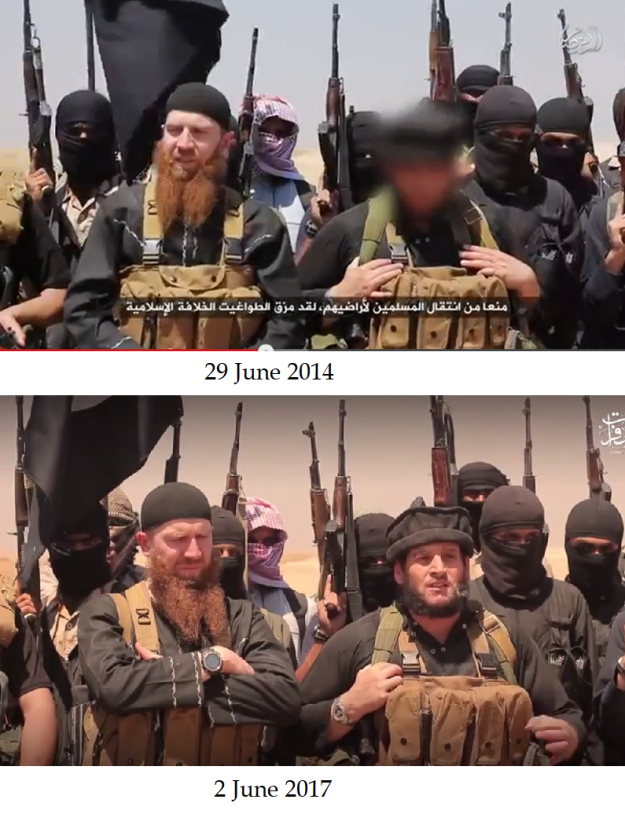
Pingback: Who Killed Adnani? An Open Source Survey – bellingcat | iExclusives
Pingback: Who Killed Adnani? An Open Source Survey – bellingcat | Farmissy
Pingback: Who Killed Adnani? An Open Source Survey – bellingcat | Posts ABC
Pingback: The End of the Islamic State by Christmas? | The Syrian Intifada
Pingback: al-Adnani’s death: A significant but not crippling loss for IS « Counter-terrorism matters
Pingback: خبر موت: طه فلاحة (أبو محمد العدناني) -
Pingback: Obituary: Wael al-Fayad (Dr. Wael al-Rawi) | The Syrian Intifada
Pingback: Obituary: Taha Falaha (Abu Muhammad al-Adnani) – Thinking Syria
Pingback: The Islamic State and Chemical Weapons | The Syrian Intifada
Pingback: Abu Bakr al-Baghdadi Calls for the Islamic State to Stand Firm in Mosul | The Syrian Intifada
Pingback: Al-Qaeda Explains its Split with the Islamic State | The Syrian Intifada
Pingback: The Inaugural Address of the Islamic State’s New Spokesman | The Syrian Intifada
Pingback: Ideologue Laments A Jihadist Joining the Islamic State | The Syrian Intifada
Pingback: The Seeds of the Islamic State in Saddam’s Iraq | The Syrian Intifada
Pingback: The Caliph’s First Deputy | The Syrian Intifada
Pingback: Abdallah Najem al-Jawari: A Key Early Leader of the Islamic State | The Syrian Intifada
Pingback: The Man Who Planned the Islamic State’s Takeover of Mosul | The Syrian Intifada
Pingback: The Islamic State Explains Its Secret To Success | The Syrian Intifada
Pingback: Bomber in New York and New Jersey Influenced By Jihad | The Syrian Intifada
Pingback: GUEST POST: Jihadist Groups In The Sahel Region Formalize Merger
Pingback: Obituary: Abd al-Rahman Mustafa al-Qaduli (Abu Ali al-Anbari) | The Syrian Intifada
Pingback: The Official Declaration that Made Abu Bakr al-Baghdadi Leader of the Islamic State | The Syrian Intifada
Pingback: The Continuing Syrian Efforts to Resist Jihadism | The Syrian Intifada
Pingback: U.S. Treasury Targets Al-Qaeda in Syria | The Syrian Intifada
Pingback: America Sanctions the Islamic State’s Intelligence Chief | The Syrian Intifada
Pingback: The Islamic State’s Media Apparatus and its New Spokesman | The Syrian Intifada
Pingback: Coalition Prepares the Ground for Mosul Offensive | The Syrian Intifada
Pingback: Activist Group Lists Ten Most Important Islamic State Leaders Killed | The Syrian Intifada
Pingback: Defeating the Islamic State for Good | The Syrian Intifada
Pingback: The Coalition’s Flawed Endgame Strategy for the Islamic State | The Syrian Intifada
Pingback: An Ideological Founder of Islamic State is Killed in Syria | The Syrian Intifada
Pingback: Liberating Raqqa from the Islamic State | The Syrian Intifada
Pingback: An American Jihadist At the Top of the Islamic State | The Syrian Intifada
Pingback: Islamic State Likely To Increase Terrorism Against Turkey | The Syrian Intifada
Pingback: Islamic State Operative Connected to Charlie Hebdo Attack Might Still Be Alive | The Syrian Intifada
Pingback: America Sanctions Operatives of the Islamic State’s Chemical Weapons Department | The Syrian Intifada
Pingback: The Coalition Targets Islamic State Propagandists and External Terrorists | The Syrian Intifada
Pingback: A Frenchman Directing the Islamic State’s Foreign Attacks | The Syrian Intifada
Pingback: The Islamic State’s Terrorism Guides | The Syrian Intifada
Pingback: Islamic State Has Been Defeated in Al-Bab, But America Needs a New Direction in Syria | The Syrian Intifada
Pingback: Islamic State Recommends More Gentleness in Dealing With Sinners | The Syrian Intifada
Pingback: Russia’s Unreliable Claims About the Islamic State | The Syrian Intifada
Pingback: The Spokesman’s Response When the Islamic State Went to War With the Syrian Rebellion | Kyle Orton's Blog
Pingback: Islamic State Profiles the Godfather of its Media Department | Kyle Orton's Blog
Pingback: A Myth Revisited: “Saddam Hussein Had No Connection To Al-Qaeda” - Kyle Orton's Blog
Pingback: An Ideological Founder of Islamic State is Killed in Syria - Kyle Orton's Blog